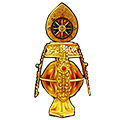
Vimalakirti Nirdesa Sutra
A Detailed Exposition by Living Buddha Lian Sheng, Grandmaster Sheng-Yen Lu
Translated into English by the True Buddha School Vimala Sutra Translation Team
Discourse 54, 17 December 2022 - Chapter One—Buddhaverse (Continued)
Chapter One—Buddhaverse
The Buddha was surrounded by a large gathering of respectful attendees listening to the dharma. Sitting at ease on the precious lion throne, the Buddha appeared like Mount Meru towering above the ocean of attendees surrounding him below.
At that time in Vaisali City, there was an elder named Treasure Cumulation. Together with 500 (many) other elders, they came along with parasols embellished with the seven precious jewels, paid homage to the Buddha by touching his feet with their heads. They then made offering of those parasols to the Buddha.
Now we will talk about the Vimalakirti Sutra. Last time I covered up until this part:
In the assembly, there were… all the bhiksus, bhiksunis, upasakas, and upasikas.
The ordained bhiksus, bhiksunis, the male and female lay practitioners all came to attend the grand ceremony where the Buddha gave a dharma teaching which was later called the Vimalakirti Sutra.
The Buddha was surrounded by a large gathering of respectful attendees listening to the dharma. Sitting at ease on the precious lion throne, the Buddha appeared like Mount Meru towering above the ocean of attendees surrounding him below.
At that moment, Sakyamuni Buddha was like Mount Meru. It is written in the Buddhist sutras that Mount Meru is the highest mountain in the small thousand worlds. At its peak is the Heaven of Lord Indra (Trayastrimsa Heaven) while at its slope is the Heaven of the Four Heavenly Kings.
When Sakyamuni Buddha was giving his dharma teaching to the assembly surrounding him below, he appeared like Mount Meru towering over the ocean. Mount Meru is eighty thousand yojanas tall from the ground up and another eighty thousand yojanas deep underneath the ground. The yojana is a measurement unit in ancient India. How many Mount Merus are there? In the three-thousand-great-thousand worlds, there are numerous Mount Merus, as mentioned in the Buddhist sutras.
In this dharma teaching, the Buddha sat on his precious lion throne at the center, like Mount Meru—the king of all mountains, surrounded by a huge number of sentient beings including bodhisattvas, bhiksus, bhiksunis, upasakas, upasikas, the eight divisions of gods and dragons, the heavenly beings, Mahabrahma devas, etc., which are likened to the seas underneath him.
He was seated on a lion throne made of seven treasures—gold, silver, precious gems, and engraved with lions. In the High King Avalokitesvara Sutra, we chant the Sumeru Light King Buddha announced by the Buddha. This buddha has the precious thrones of all buddhas of the ten directions. When Sakyamuni Buddha gave dharma teachings, he always sat on the precious Lion Throne—a very special dharma throne belonging to Sakyamuni Buddha—surrounded by the attendees.
At that time in Vaisali City, there was an elder named Treasure Cumulation. Together with 500 (many) other elders…
At that time, in Vaisali City, there was an elder… We need to explain this Chinese term zhangzhezi.[1] It means “elder.” This term has often been mistaken for the son of an elder, where in fact, it means “elder.” The Chinese character “zi” generally refers to “son”, however, it is also used as an honorific address, such as in “Laozi,” “Mengzi,” “Mozi,” “Kongzi” or “Kong Fu Zi”—the Chinese names of Confucius.
There were many elders in the Vaisali City. “Elder” is often mentioned in the Buddhist sutras. For example, the Elder Anathapindika, whose name means “an elder who looked after helpless isolated people.” He gifted his grove—Anathapindika Monastery—to Sakyamuni Buddha.
What does “elder” mean? It has several meanings. First, an elder must belong to nobility. There are four castes or social classes in India: the nobility or spiritual practitioners, the royals, the merchants, and the laborers. An elder must belong to the first class of the caste system. Second, he must be very rich. Like Xu Dequan [the master with a name sounding like “Lots of Money”]. So perhaps when “Lots of Money” has gotten older, he will become an elder. [laughing]
So, an elder must be a nobleman. Second, he must own lots of money. Third, he must have high moral standard. And fourth, he must be an elderly. In my opinion, these four requirements are more important than being honorable, charitable, with good character, respectable and other traits.
We have eight elders in our True Buddha School now. They are worthy of our respect. I suppose we can call them “zhang lao zi” and it does not mean the son of the elder. “Zi’ is added as an honorary title in ancient times.
At that time in Vaisali City, there was an elder named Treasure Cumulation.
Treasure Cumulation is a bodhisattva, whose name means that he has dharma treasures—buddhadharma—on him. He knows a great deal of buddhadharma, therefore his name is Treasure Cumulation. He is an elder who has accumulated countless dharma treasures. This is what it means.
Together with 500 (many) other elders…
In the Buddhist sutra, 500 means many and it does not mean exactly 500. We often read in the Buddhist sutra that there were 500 merchants crossing the river or references to 500 bandits. This meant there were many of them. So, “500 elders” mean there were many elders, who were elderly, wealthy, with outstanding moral character, like the bodhisattvas. We respectfully call them elders and there were many of them.
Om mani padme hum.
[1] 長者子
Next discourse on the Vimalakirti Sutra: Discourse 55, 24 December 2022 - Chapter One—Buddhaverse (Continued)
Previous discourse on the Vimalakirti Sutra: Discourse 53, 10 December 2022 - Chapter One—Buddhaverse (Continued)
Index of links to all discourse on the Vimalakirti Sutra: https://en.tbsn.org/guidem/detail/2975/
Back to the main index page of all dharma discourse: https://en.tbsn.org/guidem/index
Full webcast of 2022.12.17 Yamantaka Homa Ceremony (Taiwan Lei Tsang Temple) and dharma discourse with English interpretation: https://youtu.be/Lz5iDLDxXVU




